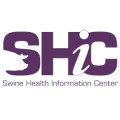 This effort helps the organization fulfill its mission to generate new intelligence for preventing, preparing for, and responding to emerging swine disease threats. Areas of funded research span across the Center’s five strategic priorities: improve swine health information, monitor and mitigate risks to swine health, respond to emerging disease, surveillance and discovery of emerging disease, and swine disease matrices. The nine new projects were initiated in summer 2024 and are six to 12 months in duration. Research outcomes from the funded projects will provide critical information and resources to help pork producers as they face emerging disease challenges in their swine herds.
This effort helps the organization fulfill its mission to generate new intelligence for preventing, preparing for, and responding to emerging swine disease threats. Areas of funded research span across the Center’s five strategic priorities: improve swine health information, monitor and mitigate risks to swine health, respond to emerging disease, surveillance and discovery of emerging disease, and swine disease matrices. The nine new projects were initiated in summer 2024 and are six to 12 months in duration. Research outcomes from the funded projects will provide critical information and resources to help pork producers as they face emerging disease challenges in their swine herds.
Newly funded projects addressing SHIC’s research priorities include: disease spillover risks from wean-to-market pigs to sow herds, whole genome sequencing as a forensic diagnostic tool, pathogenesis and interpretation of test results for porcine circoviruses, early disease outbreak warning signals, population based sample types for emerging disease testing, domestic disease monitoring for bacterial pathogens, clinical relevance of newly identified agents or syndromes from veterinary diagnostic lab submissions, and informing the swine disease matrices to prioritize pathogens for research and diagnostics.

The SHIC 2024 Plan of Work call for research proposals was announced in January 2024 and received 43 proposals from 21 different institutions by the submission deadline of March 2024. Funding available for this RFP totaled $1.1 million. Funding timely research is an essential component of SHIC providing project outcomes that drive action for emerging disease prevention, preparedness, mitigation, and response for the US swine industry.
SHIC 2024 Plan of Work projects funded and initiated in response to the RFP include:
Improve Swine Health Information
Developing and implementing a capability for real-time monitoring of Escherichia coli genotyping and virotypes detected in porcine samples tested by PCR
- PI: Giovani Trevisan, Iowa State University
- Objective: To integrate coli genotyping and virotyping detection data from major swine-centric VDLs and organize continuous reporting of this pathogen detection through SDRS.
Monitor and Mitigate Risks to Swine Health
Implementing a real-time surveillance system utilizing diagnostics, movement, and site location for early detection of emerging/re-emerging diseases across different regional levels
- PI: Gustavo Silva, Iowa State University
- Objective: To implement a real-time surveillance system for PRRSV utilizing diagnostic, movement, and site location data across different regional levels.
Respond to Emerging Diseases
Reproductive failure induced by porcine circovirus type 3 infection in experimentally infected sows
- PI: Pablo Pineyro, Iowa State University
- Objective: To characterize the role of PCV3 infection on reproductive failure and evaluate differences in the clinical outcome associated with different times of infection; develop a sow challenge model for investigating PCV3 control strategies.
Atypical interstitial pneumonia-like disease in swine: etiologic investigation of an emergent syndrome
- PI: Marcelo Almeida, Iowa State University
- Objective: To investigate possible causes for an emergent syndrome in pigs with lesions of diffuse alveolar damage through PCR of tissues, characterization by IHC, and whole genome sequencing for endemic agents and novel pathogen discovery.
Exploratory study to evaluate the presence of PCV4 in different sample matrices and confirmation of its role in histological changes by direct detection
- PI: Pablo Pineyro, Iowa State University
- Objective: To determine detection rate of PCV4 in various clinical sample types, its role in the pathological process, and its prevalence in co-infections with other endemic pathogens.
Surveillance and Discovery of Emerging Diseases
Establishing oral fluid sampling guidelines for group-housed sows
- PI: Jeff Zimmerman, Iowa State University
- Objective: To establish best practices for oral fluid collection from group-housed sows considering gestation stage, parity, and pen size, and quantify the reliability of oral fluid sampling in group-housed sows using a surrogate.
Surveillance and pathogenicity of mammalian orthoreovirus, adenovirus and novel pathogens in pigs

- PI: Wenjun Ma, University of Missouri
- Objective: To determine the prevalence, epidemiology, pathogenicity, and transmissibility of mammalian orthoreovirus and porcine adenoviruses, the contribution to clinical disease and identify novel viral pathogens in US swine herds.
Validation of a new enrichment method for increasing sensitivity of PRRSV whole genome sequencing
- PI: Leyi Wang, University of Illinois Urbana Champaign
- Objective: To develop and validate capture probe-based enrichment to increase sensitivity of whole genome sequencing of PRRSV across different sample types such as sera, lungs, oral fluids, processing fluids, and tongue tip fluids.
Swine Disease Matrices
Generating a disease index based on confirmed tissue diagnosis data to assess the relative burden of endemic swine pathogens in the U.S.
- PI: Giovani Trevisan, Iowa State University
- Objective: Utilize diagnostic data to build a disease index and update the swine disease matrices in support of prioritizing target pathogens for swine health research.
September, 2024 - SHIC



